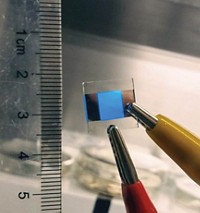Advertisement
Grab your lab coat. Let's get started
Welcome!
Welcome!
Create an account below to get 6 C&EN articles per month, receive newsletters and more - all free.
It seems this is your first time logging in online. Please enter the following information to continue.
As an ACS member you automatically get access to this site. All we need is few more details to create your reading experience.
Not you? Sign in with a different account.
Not you? Sign in with a different account.
ERROR 1
ERROR 1
ERROR 2
ERROR 2
ERROR 2
ERROR 2
ERROR 2
Password and Confirm password must match.
If you have an ACS member number, please enter it here so we can link this account to your membership. (optional)
ERROR 2
ACS values your privacy. By submitting your information, you are gaining access to C&EN and subscribing to our weekly newsletter. We use the information you provide to make your reading experience better, and we will never sell your data to third party members.
Materials
Quantum Dots Shine In LEDs
Nanotechnology: By swapping electrode materials, researchers boost device efficiency and brightness
by Katherine Bourzac
April 10, 2012

Television and computer displays based on light-emitting quantum dots promise more vibrant images while using half the power of organic light-emitting diodes. However, compared to the best commercial technology, LEDs using quantum dots are power hungry and produce low-quality images. Now researchers have implemented a new design to create red, green, and blue quantum-dot devices that are brighter and more efficient (Nano Lett., DOI: 10.1021/nl3003254).
Quantum dots are inorganic semiconducting nanoparticles that, depending on their size, emit light at specific wavelengths. Because this light falls in a narrow range of wavelengths, researchers think the particles could enable beautifully colored displays that produce light at the wavelengths to which our eyes are most sensitive. Quantum dots can also form inks for printing, which should reduce their production costs.
Unfortunately, current quantum-dot light-emitting diodes (QLEDs) have low efficiencies: The devices convert only 2 to 3% of the electrical charge used to power them into light that reaches a viewer’s eye. In comparison, most commercial organic LEDs have efficiencies around 6%, with the best, and most expensive, approaching 20%.
The problem isn’t in the quantum dots themselves, but in the structures that deliver current to the particles, explains Changhee Lee, professor of electrical engineering and computer science at Seoul National University. Normally, researchers make QLEDs by sandwiching a layer of quantum dots between two electrodes: a cathode at the back of the device made of metal such as aluminum, and an anode at the front made of indium tin oxide. Because indium tin oxide is transparent, the emitted light can escape from the device. But the material makes a poor anode, Lee says, and as a result, little charge reaches the light-emitting layer.
Lee, Kookheon Char, Seonghoon Lee, and their colleagues worked around this problem by turning the device design upside down. They made indium tin oxide act as the cathode instead of the anode. To enable this, they topped the material with a layer of zinc oxide nanoparticles, which helps inject electrons into the quantum dots. Like the quantum dots, the nanoparticles are amenable to printing. Adding aluminum as the anode, the researchers made red, green, and blue QLEDs with efficiencies of 7.3, 5.8, and 1.7%, respectively. The QLEDs are also bright: The green device is the brightest ever measured, producing 218,800 candelas per m2.
“These QLEDs are by far the best in the literature,” says Seth Coe-Sullivan, founder of QD Vision, a company that is developing QLED displays. In May, 2011, at the Society for Information Display conference in Los Angeles, QD Vision demonstrated a full-color prototype display using an inverted QLED structure. The company has not published the work, but it reports efficiencies around 18% for its red QLEDs.
Lee is also working on a QLED display and on improving his QLEDs’ lifetimes.





Join the conversation
Contact the reporter
Submit a Letter to the Editor for publication
Engage with us on Twitter